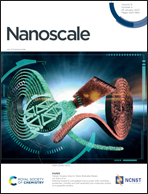Interlayer exciton landscape in WS2/tetracene heterostructures†
Abstract
The vertical stacking of two-dimensional materials into heterostructures gives rise to a plethora of intriguing optoelectronic properties and presents an unprecedented potential for technological development. While much progress has been made combining different monolayers of transition metal dichalcogenides (TMDs), little is known about TMD-based heterostructures including organic layers of molecules. Here, we present a joint theory–experiment study on a TMD/tetracene heterostructure demonstrating clear signatures of spatially separated interlayer excitons in low temperature photoluminescence spectra. Here, the Coulomb-bound electrons and holes are localized either in the TMD or in the molecule layer, respectively. We reveal both in theory and experiment signatures of the entire intra- and interlayer exciton landscape in the photoluminescence spectra. In particular, we find both in theory and experiment a pronounced transfer of intensity from the intralayer TMD exciton to a series of energetically lower interlayer excitons with decreasing temperature. In addition, we find signatures of phonon-sidebands stemming from these interlayer exciton states. Our findings shed light on the microscopic nature of interlayer excitons in TMD/molecule heterostructures and could have important implications for technological applications of these materials.



 Please wait while we load your content...
Please wait while we load your content...